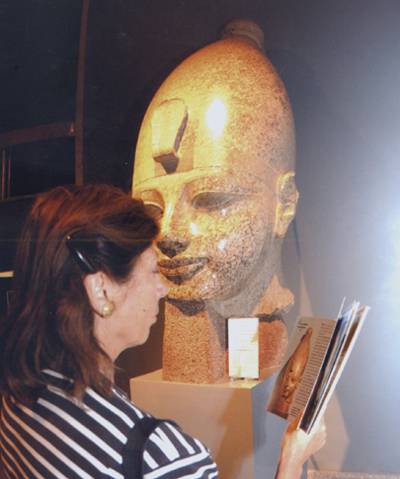 Two of the most important
royal pharaohs from Egypt’s New Kingdom, Ramses I and Ahmose I have been returned to
their spiritual home in Luxor (ancient Thebes) where they ruled more than three and a half
thousand years ago. A new wing at the Luxor Museum has been added to house them and will
be opened later this month. The mummies will form an essential part of an exhibition in
the new extension, which is devoted to the Egyptian army in the Golden Age of the New
Kingdom. Two of the most important
royal pharaohs from Egypt’s New Kingdom, Ramses I and Ahmose I have been returned to
their spiritual home in Luxor (ancient Thebes) where they ruled more than three and a half
thousand years ago. A new wing at the Luxor Museum has been added to house them and will
be opened later this month. The mummies will form an essential part of an exhibition in
the new extension, which is devoted to the Egyptian army in the Golden Age of the New
Kingdom.
In the early days of Ancient Egypt, warriors used only simple equipment to wage war on
foreign tribes. The pharaohs of the New Kingdom, however, adopted new fighting techniques
and military strategies such as the use of siege equipment, archers and charioteers. On
display will be a broad collection of this military paraphernalia including swords,
knives, war chariots, armoured shields and arrows, along with stone balls and instruments
used to sharpen weapons. Also on display will be the statues of well-known warrior kings
such as the black granite statue is of Tuthmosis III, who led Egypt to victory against the
Hittites at Megiddo and the black schist statue of Ramses III, who defeated the Libyans
and fought against "the people of the sea".The mummy of Ramses I is believed
to have been taken out of Egypt in 1871, as part of a sell-off of treasures looted from
Luxor's Valley of the Kings. Tomb robbers from the Abdel-Rasoul family had found the cache
of royal mummies at Deir Al-Baheri, and had sold off a number of them along, with coffins
and funerary artefacts. The mummy then came into the possession of Canada's Niagara Falls
Museum, from where it went to the Michael C Carlos Museum. There it was subjected to
several intensive studies to determine its identity. When the curators realised that there
was a 90 per cent chance that the mummy was that of Ramses I, they offered to return it to
Egypt. It was officially handed over last October.
The mummy of Ahmose I was also among the royal mummies recovered from the Deir Al-Bahari
cache. Since then it has been on display with its counterparts in the Mausoleum of Royal
Mummies at the Egyptian Museum.
Thornborough update
Last month English Heritage made a statement confirming that the Thornborough henges
are designated as Scheduled Ancient Monuments, together with the associated cursus and
adjoining landscape. This means that they are safe from destruction, but English Heritage
remains deeply concerned. Current gravel extraction in the area was granted to Tarmac
Northern by North Yorkshire County Council, who are currently studying an application by
Tarmac to extend its operations. English Heritage are particularly concerned about the
area known as Ladybridge Farm and Thornborough Moor, which could see extraction right up
to the edge of the henges themselves. EH are currently employing Dr Jan Harding of
Newcastle University to undertake extensive archaeological research on the Thornborough
landscape in order that the whole complex can be more clearly understood. EH themselves
remain firmly opposed to any further gravel extraction and believe the most appropriate
future for the area would be as a managed grassland, with increased public access. How
much influence they have however is yet to be seen.
Next Meeting
Wednesday 2nd June at the BP Centre (Scout HQ) in Greenough Street, at 7.30 pm as
usual. However due to unavoidable circumstances we have a change of plan for the next
meeting. Tony Burnett will be unable to give his talk this month, so John Johnson has
kindly agreed to exchange dates. In Tony will now gives his talk in July.
Ahmose and Kamose
John has recently been researching a new topic, which he has agreed to present to us on
Wednesday night. The period of his research is 17th and 18th Dynasty at the very birth of
the New Kingdom in ancient Egypt. It dates from the middle of the 16th century BC and
covers the reigns of Ahmose I (see above) and his older brother Kamose. Both pharaohs
fought long campaigns against the intruding Hyksos. These Semitic tribes had been
gradually encroaching into the northern delta area taking control of much of the land in
the north of Egypt. After a series of successful battles, however, the pharaohs from
Thebes were able to drive out the Hyksos, back into the area around Palestine were they
had come from, heralding a new era of great prosperity for Egypt. Sounds like a
fascinating talk, hope to see you there. B.A.
|



